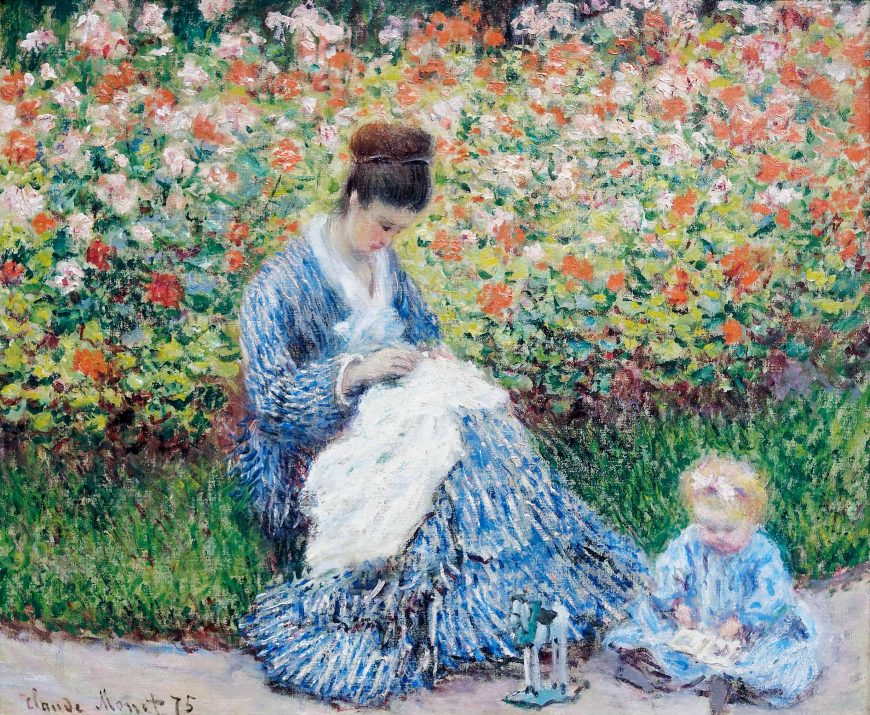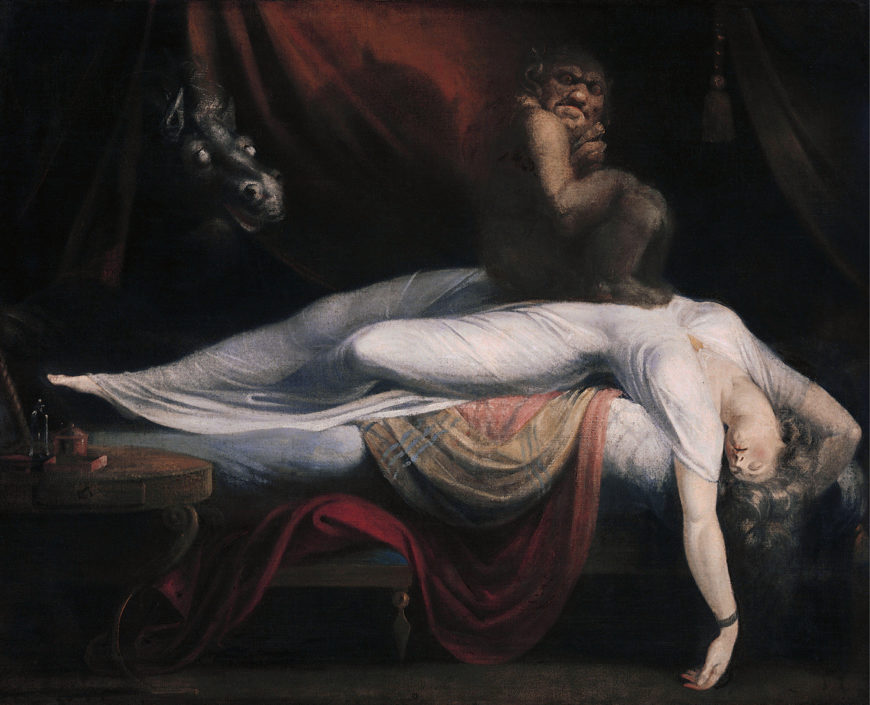Preferences and Perspectives: The Romantic Era
Romanticism Vs. Impressionism
Henry Fuseli, The Nightmare (1781)
- Woman is th emain focus
- lighting adds to the focal point and emphasis of subject matter
- Incubus has a highly detailed, ugly face lit from the ominus light source
- Reminiscent of the feeling of sleep paralysis, having a weight on your chest or seeing omnious figures in the dark
- The lines and shapes of the womans pose is idealized, she is soft, light and bright, and she's a tortured beauty as she wrestles with her nightmares.
- The edges are softer, more idealized, bending at just the right angle, blending in with portions of the background.
About This Piece
Artist: Henry Fuseli (Swiss, 1741-1825)
Medium: Oil on Canvas
Dimensions: 180 x 250 cm
Location: Detroit Institute of Arts
Horace Vernet, The Start of the Race of the Riderless Horses (1820)
- The dark and light tones create a lot of contrast, drawing your eye to multiple focal points
- immense amount of movement seen throughout the piece; struggling horse masters wrangle unruly mares. A clamor of hoofs, reins, and hands trying to control the clustered chaos.
- Provides that sense of "shock-and-awe" seen in Romanticism pieces.
About This Piece
Artist: Horace Vernet (French, 1789-1863)
Medium: Oil on Canvas
Dimensions: 46 x 54 cm
Location: The Met
Berthe Morisot, Hunting Butterflies (1874)
- Emphasis on the woman, her eyes look back at the viewer
- There is a sense of movement in the way that the woman is positioned, as if striding right out of the pianting
- The tree acts as a point of seperation between the woman and the rest of the painting
- Color is a main focus in the Impressionist pieces, giving them a depth that otherwise would not exist without their presence.
About This Piece
Artist: Berthe Morisot (French, 1841-1895)
Medium: Oil on Canvas
Dimensions: 56 x 46 cm
Location: Musée d’Orsay, Paris

Claude Monet, Camille Monet and a Child in the Artist's Garden in Argenteuil (1875)
- Tons of lines and texture provide a three dimensional effect to this snapshot in time
- The striped nature of the blue dresses is emphasized with each brush stroke, as if using them to create a movement in the piece that sells the detail in the piece
- Vibrant colors with thicker brush strokes
- With so little detail we are still able to discern Camille Monet engrossed in her needlework while her child reads a book in front of her.
- The direction of the brush strokes and the intentions behind each one ensures we know the directions and positions of the mother and daughter in regards to the garden.
- Garden is cohesive and supports the effects created within the models
About This Piece
Artist: Claude Monet (French, 1840-1926)
Medium: Oil on Canvas
Dimensions: 55.3 x 64.7 cm (21 3/4 x 25 1/2 in.)
Location: Lorna and Robert Rosenberg Gallery (Gallery 252)
Resources:
Dr. Noelle Paulson, "Henry Fuseli, The Nightmare," in Smarthistory, August 9, 2015, accessed July 17, 2024, smarthistory.org/henry-fuseli-the-nightmare/.
“Horace Vernet: The Start of the Race of the Riderless Horses.” The Metropolitan Museum of Art, 1 Jan. 1970, www.metmuseum.org/art/collection/search/437888.
“Camille Monet and a Child in the Artist’s Garden in Argenteuil.” Camille Monet and a Child in the Artist’s Garden in Argenteuil, Museum of Fine Arts, Boston, collections.mfa.org/objects/34242. Accessed 15 July 2024.
Dr. Beth Harris and Dr. Steven Zucker, "A Summer Day in Paris: Berthe Morisot’s Hunting Butterflies," in Smarthistory, May 23, 2018, accessed July 16, 2024, smarthistory.org/morisot-butterflies/.
Accessed 15 July 2024.
Dr. Charles Cramer and Dr. Kim Grant, "What does “Impressionism” mean?," in Smarthistory, December 3, 2018, accessed July 16, 2024, smarthistory.org/what-does-impressionism-mean/.
Accessed 15 July 2024.
Dr. Charles Cramer and Dr. Kim Grant, "Impressionism as optical realism: Monet," in Smarthistory, April 15, 2019, accessed July 16, 2024, smarthistory.org/impressionism-optical-realism-monet/.
Accessed 15 July 2024.


Its easy to see the difference between the Romantic versus the Impressionist art. Though the impressionist art is beautiful, I would say Romantic art is my preference of the two. In this case, The Nightmare is what draws me to chose Romantism. This is because when I was younger, I experienced sleep paralysis and was a terrifying experience to say the least. I remember not knowing what it was and doing research the next morning and The Nightmare was used a lot to showcase the heavy weight you feel on your chest during the experience. The very intentional brush strokes of the Impressionist paintings are so cool! I love the way they change to demonstrate different textures and movements.
ReplyDelete